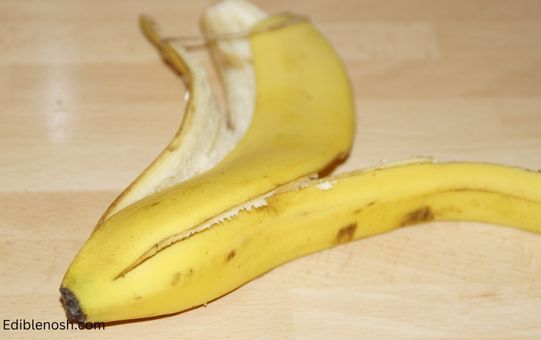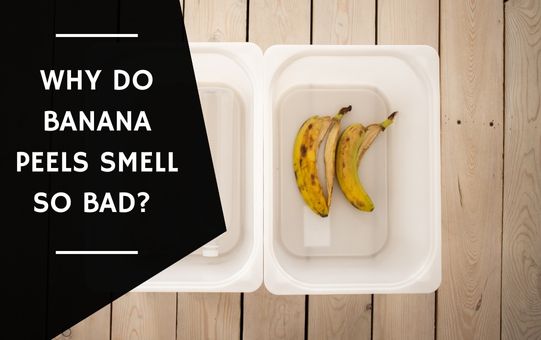Have you ever begun to wonder why do banana peels turn brown after opening, even if only a small portion of the fruit is consumed? This is a common phenomenon that many individuals have observed, but few comprehend the science underlying it.
Due to the presence of enzymes known as polyphenol oxidases, banana peels darken after being cut (PPOs). These enzymes cause the polyphenols in the peel to change color and turn brown by oxidizing them. In actual this is a naturaly occuring process that occues in all banans but it has not effect on the fruits quality.
In this article, we will delve into the mysteries surrounding the browning of banana peels and identify the underlying causes of this mysterious process.
Contents
- Why Do Banana Peels Turn Brown After Opening matter?
- What Causes Banana Peels to Turn Brown?
- How Can You Prevent Banana Peels from Turning Brown?
- Does the Browning of Banana Peels Affect the Quality of the Fruit?
- Is the Browning of Banana Peels a Sign of Spoiling?
- Conclusion
- FAQs | Banana Peels Turn Brown After Opening
Why Do Banana Peels Turn Brown After Opening matter?
The browning of banana peels after opening does not have any significant impact on the quality or safety of the fruit itself.
However, the browning of the peel can make the fruit less visually appealing, which may affect consumer preferences and purchasing decisions.
Additionally, the browning of the peel may be a sign that the fruit is starting to become overripe and may not be as fresh or flavorful as it was when it was first opened.
Understanding the causes of the browning process can help consumers to better preserve the appearance and quality of their bananas and make informed decisions about when to consume them.
Read Also: Why Do Banana Peels Split?
What Causes Banana Peels to Turn Brown?
The main cause of banana peels turning brown is the presence of enzymes called polyphenol oxidases (PPOs).
These enzymes are found in all plant tissues, including banana peels, and they play a role in the plant’s defense system by helping to protect the plant from being eaten by insects or other animals. PPOs are also responsible for the browning of fruits and vegetables when they are cut or bruised.
When a banana peel is opened, the PPOs come into contact with oxygen in the air and begin to oxidize, or break down, the polyphenols (a type of pigment) in the peel.
This process causes the polyphenols to change color and turn brown. The browning of the peel is a sign of the PPOs breaking down the polyphenols, which is a natural process that occurs in all plants.

How Can You Prevent Banana Peels from Turning Brown?
There are a few simple ways to prevent banana peels from turning brown after they have been opened.
One of the most effective ways is to cover the cut or peeled part of the banana with plastic wrap or aluminum foil. This will help to keep the PPOs from coming into contact with oxygen, which will slow down the browning process.
Another way to prevent banana peels from turning brown is to store the bananas in the refrigerator. The cold temperature of the fridge will slow down the activity of the PPOs and prevent the browning process from occurring as quickly.
Finally, you can also try adding a small amount of lemon juice to the cut or peeled part of the banana. The acid in the lemon juice will help to inhibit the activity of the PPOs and prevent the banana peel from turning brown.
Does the Browning of Banana Peels Affect the Quality of the Fruit?
The browning of banana peels does not affect the quality of the fruit itself, but it can make the peel less visually appealing.
However, the browning of the peel is a natural process that occurs in all bananas, and it does not make the fruit any less safe to eat.
In fact, some people even prefer to eat bananas that are slightly overripe, as the fruit tends to be sweeter and more flavorful when it is slightly brown.
Is the Browning of Banana Peels a Sign of Spoiling?
While the browning of banana peels is a natural process that occurs in all bananas, it is not a sign that the fruit is spoiled.
Bananas can remain fresh and safe to eat for several days, even if the peel has turned brown.
However, if the fruit itself becomes soft or mushy, or if it develops an off odor or taste, it is likely that the banana has spoiled and should not be eaten.
Read Also: Why Do Banana Peels Smell so Bad?
Conclusion
The browning of banana peels is a natural and fascinating process that occurs due to the presence of enzymes called polyphenol oxidases (PPOs). While it may not be the most visually appealing aspect of bananas, it is important to remember that the browning of the peel does not affect the quality or safety of the fruit itself.
Understanding the science behind why banana peels turn brown can help us to better preserve the appearance and quality of this popular and delicious fruit. Whether you prefer your bananas yellow or slightly brown, there’s no denying that they are a nutritious and tasty addition to any diet.
So, the next time you notice your banana peel turning brown, take a moment to appreciate the complex and interesting processes that are occurring within the fruit.
FAQs | Banana Peels Turn Brown After Opening
Here are a few FAQs that are usually asked by people around the world.
What Causes Banana Peels To Turn Brown?
The main cause of banana peels turning brown is the presence of enzymes called polyphenol oxidases (PPOs). These enzymes are found in all plant tissues, including banana peels, and they play a role in the plant’s defense system by helping to protect the plant from being eaten by insects or other animals.
When a banana peel is opened, the PPOs come into contact with oxygen in the air and begin to oxidize, or break down, the polyphenols (a type of pigment) in the peel. This process causes the polyphenols to change color and turn brown.
Can You Prevent Banana Peels From Turning Brown?
Yes, there are a few simple ways to prevent banana peels from turning brown after they have been opened. One of the most effective ways is to cover the cut or peeled part of the banana with plastic wrap or aluminum foil.
This will help to keep the PPOs from coming into contact with oxygen, which will slow down the browning process.
Another way to prevent banana peels from turning brown is to store the bananas in the refrigerator.
Does The Browning Of Banana Peels Affect The Quality Of The Fruit?
No, the browning of banana peels does not affect the quality of the fruit itself. The browning of the peel is a natural process that occurs in all bananas, and it does not make the fruit any less safe to eat.
In fact, some people even prefer to eat bananas that are slightly overripe, as the fruit tends to be sweeter and more flavorful when it is slightly brown.
Is The Browning Of Banana Peels A Sign Of Spoiling?
No, the browning of banana peels is a natural process that occurs in all bananas, and it is not a sign that the fruit is spoiled. Bananas can remain fresh and safe to eat for several days, even if the peel has turned brown.
However, if the fruit itself becomes soft or mushy, or if it develops an off odor or taste, it is likely that the banana has spoiled and should not be eaten.
Can You Eat A Banana If The Peel Is Brown?
Yes, you can eat a banana if the peel is brown. The browning of the peel is a natural process that occurs in all bananas, and it does not affect the quality or safety of the fruit itself.
However, if the fruit itself has become soft or mushy, or if it has developed an off odor or taste, it is likely that the banana has spoiled and should not be eaten.

